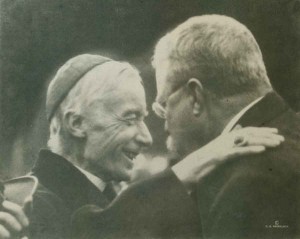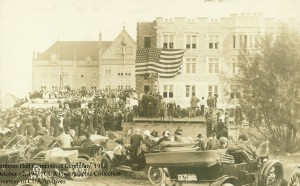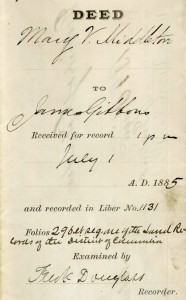
James, Cardinal Gibbons was a key figure in American Catholic history as a major leader and spokesman of the Church during a tumultuous time of industrial growth, contentious immigration, and structural change in American society. He was also a founder and first Chancellor of The Catholic University of America (CUA), where his presence on campus is commemorated by Gibbons Hall (see image below). He also presides over the CUA campus in many guises, most notably as a marble bust in McMahon Hall and a large oil on canvas painting in Mullen Library. There is also a small collection of his archival papers preserved in the CUA Archives and another, larger cache with the Archdiocese of Baltimore.
The future Cardinal was born in Baltimore to Irish immigrants on July 23, 1834 and received his priestly training at St. Charles College and High School and St. Mary’s Seminary. He was ordained in 1861, just in time to serve as a Civil War chaplain at Fort McHenry (already famous from the War of 1812), which was then a prison for both captured Confederate soldiers and Maryland civilians who were suspected rebel sympathizers.

Following the war, Gibbons worked as secretary to Archbishop Martin John Spalding of Baltimore . In 1868, Pope Leo XIII appointed the upwardly mobile Gibbons as Apostolic Vicar of North Carolina and Titular Bishop of Adramyttium or Adramitto. It was while he was in North Carolina that Gibbons, now widely known as ‘The Boy Bishop’, wrote his most important book: Faith of Our Fathers.
Gibbons was named administrator of the Diocese of Richmond in January 1872 and bishop of Richmond in July. In May 1877 he was appointed coadjutor with right of succession to Archbishop James Roosevelt Bayley of Baltimore and became Archbishop upon Bayley’s death in October of that year. In this role he hosted the Third Plenary Council in 1884. In 1886, Pope Leo XIII elevated Gibbons to the rank of Cardinal, only the second American to be so, and hosted the new Cardinal in Rome the following year.

As a Cardinal, Gibbons became the voice for American Catholics, responsible for speaking on behalf of labor in America, in particular the Knights of Labor via his relationship with noted labor leader and government reformer Terence V. Powderly (see more).
Gibbons, along with John Lancaster Spalding, Bishop of Peoria was instrumental in the founding of The Catholic University of America (CUA) in Washington, D.C. as a national intellectual center that would train American born clergy and fight anti-Catholic prejudice.
Cardinal Gibbons was also a confidant to American Presidents such as Theodore Roosevelt and William Howard Taft. Roosevelt was the keynote speaker at Gibbons’ 1911 Jubilee for fifty years as a priest and twenty-five years as Cardinal.
Gibbons died on March 24, 1921, with his impact on American Catholicism celebrated most famously by the Knights of Columbus memorial commissioned by President Calvin Coolidge in 1928 and completed in 1932.
